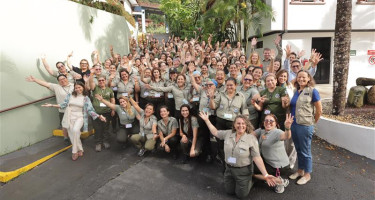Strengthening Local Structures for Greater Resilience
In Cuba, Haiti, and the Dominican Republic, the Caribbean Resilient Communities (CCR, from its acronym in Spanish) project promotes participatory governance structures, community networks, and strategic partnerships to tackle the climate crisis. This article shares inspiring examples of how organized communities are advancing ecosystem-based adaptation (EbA), strengthening their autonomy, and paving the way toward a more just and sustainable future.

©Welthungerhilfe
Strengthening local governance structures is at the heart of several activities under the Caribbean Resilient Communities (CCR, from its acronym in Spanish) project. Across different regions of Cuba, Haiti, and the Dominican Republic, diverse approaches show how participatory processes, networks, and strategic alliances among various actors reinforce climate resilience and catalyze long-term sustainable impacts.
Profound Dialogues in the Dominican Republic
During a workshop held in Santo Domingo, representatives from Enda Dominicana, Centro Naturaleza, and Welthungerhilfe and OroVerde, together with Dr. Petra Speier-Werner (an expert in Multi-Actor Partnerships, Civil Society Academy), analyzed the development and consolidation of the groups known as “Grupos Contenedores.” These multisectoral governance hubs have been promoted by the CCR project to coordinate climate change adaptation at the municipal level. The workshop’s objective was to map out strategies to ensure their sustainability beyond the project, by integrating them into formal structures such as the Municipal Development Councils (CDM, from its acronym in Spanish).
In the Dajabón region, the group has become a point of reference in local governance. One analysis highlighted how participatory methods, inclusive decision-making processes, and developing strategic capacities have strengthened a collective identity that drives commitment and autonomous problem-solving.

©OroVerde
Participation in Cuba
In the Baconao Biosphere Reserve, in the communities of Las Guásimas and El Carpintero, local governance is also taking center stage. There, “Grupos Gestores” were formed with participation from farmers, homemakers, cooperative members, and local authorities. Supported by a multisectoral Facilitation Committee – composed of key actors, such as the State Forestry Service, Aguas Santiago (a water company), ANAP, and the local government – these structures ensure transparency, shared responsibility, and a strong social foundation for Ecosystem-based Adaptation (EbA) measures.
Also, on the eastern side of the island, in the Cuchillas del Toa Biosphere Reserve in Guantánamo province, local governance structures are being established at the provincial, municipal, and local levels to coordinate implementation of the EbA adaptation strategy. Coordination between the “Plan Turquino” (at the provincial level), the municipality of Yateras, and several local communities (including members of the popular council) aims to reinforce climate resilience in the territory through the coordinated implementation of EbA measures.

©Welthungerhilfe
Community Momentum for Resilience in Haiti
In Haiti, despite the serious political and security crisis affecting the country – particularly the metropolitan area centered around the capital – local governance for EbA and climate resilience has gained strength in recent months within CCR project communities in the southeast. In the municipalities of Thiotte, Anse-à-Pitres, and Grand-Gosier, the “Grupos Contenedores” have adopted names that reflect their shared mission: “COCHARET,” “COPROBEA,” and “COCIREGG” are the acronyms of these new citizen associations committed to the conservation of their community’s environment.
Recognizing that natural ecosystems provide essential services such as clean water, air, and fertile soils – on which the well-being of rural communities depends – environmental protection and active restoration is the central focus of local climate adaptation strategies. This mission is clearly outlined in their internal statutes and aligns with the adaptation priorities of the EbA Plans that the CCR Project developed for each community last year, the implementation of which has already begun on the ground in 2025.

©Concert Action
Local Governance as a Key to Sustainable Adaptation
These examples demonstrate that the success of climate change adaptation not only depends on measures implemented on the ground, but also – crucially – on social and institutional organization at the local level, on raising awareness, community mobilization and participation, technical training, and equitable, meaningful empowerment. All of this contributes to building Caribbean communities that are more resilient in the face of the global climate crisis and other simultaneous challenges at the local level.
The CCR project strengthens these structures through systematic support, capacity-building processes, and the active inclusion of the diverse actors.

©Concert Action
- Country: Cuba, Haití, Dominican Republic
- Project:
- Contact:
Nina Gawol


